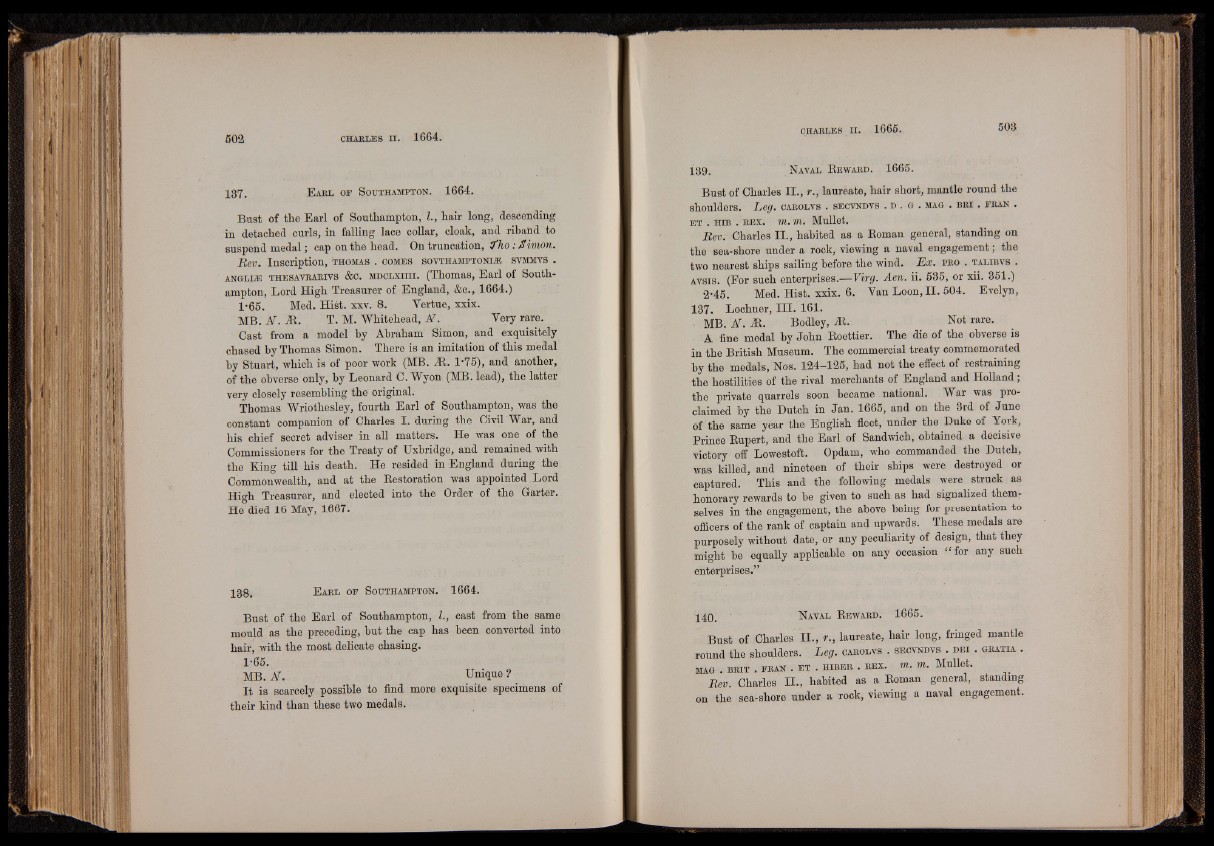
1 3 7 . E arl o p S o u th am p to n . 1664.
Bust of the Earl of Southampton, I., hair long, descending
in detached curls, in falling lace collar, cloak, and riband to
suspend medal j cap on the head. On truncation, t/'lio. S zition.
Rev. Inscription, th om a s . come s so v th am pton l® symmvs .
a n g l l e t h e sa v r a r iv s &c. MDCLXHii. (Thomas, Earl of Southampton,
Lord High Treasurer of England, &c., 1664.)
1-65. Med. Hist. xxv. 8. Yertue, xxix.
MB. Af. M. T. M. Whitehead, AC. Very rare.
Cast from a model by Abraham Simon, and exquisitely
chased by Thomas Simon. There is an imitation of this medal
by Stuart, which is of poor work (MB. At. 1‘75), and another,
of the obverse only, by Leonard C. Wyon (MB. lead), the latter
very closely resembling the original.
Thomas Wriothesley, fourth Earl of Southampton, was the
constant companion of Charles I. during the Civil War, and
his chief secret adviser in all matters. He was one of the
Commissioners for the Treaty of Uxbridge, and remained with
the King till his death. He resided in England during the
Commonwealth, and at the Restoration was appointed .Lord
High Treasurer, and elected into the Order of the Garter.
He died 16 May, 1667.
138. Eabl o f S o u th am pto n . 1664.
Bust of the Earl of Southampton, L, cast from the same
mould as the preceding, but the cap has been converted into
hair, with the most delicate chasing.
1-65.
MB. AT. Unique ?
I t is scarcely possible to find more exquisite specimens of
their kind than these two medals.
Bust of Charles II., r., laureate, hair short, mantle round the
shoulders. Leg. carolvs . secvndvs . d . g . mag . b r i . f r a n .
e t . h ib . r e x . m. m. Mullet.
Rev. Charles II., habited as a Roman general, standing on
the sea-shore under a rock, viewing a naval engagement; the
two nearest ships sailing before the wind. Ex. pr o . ta l ib v s .
a v s is . (For such enterprises.—Virg. Aen. ii. 535, or xii. 351.)
2'45. Med. Hist. xxix. 6. Van Loon, II. 504. Evelyn,
137. Lochner, HI. 161.
MB. M. At. Bodley, At. Not rare.
A fine medal by John Roettier. The die of the obverse is
in the British Museum. The commercial treaty commemorated
by the medals, Nos. 124—125, had not the effect of restraining
the hostilities of the rival merchants of England and Holland;
the private quarrels soon became national. War was proclaimed
by the Dutch in Jan. 1665, and on the 3rd of June
of the same year the English fleet, under the Duke of York,
Prince Rupert, and the Earl of Sandwich, obtained a decisive
victory off Lowestoft. Opdam, who commanded the Dutch,
was killed, and nineteen of their ships were destroyed or
captured. This and the following medals were struck as
honorary rewards to be given to such as had signalized thenu-
selves in the engagement, the above being for presentation to
officers of the rank of captain and upwards. These medals are
purposely without date, or any peculiarity of design, that they
might be equally applicable on any occasion “ for any such
enterprises.”
1 4 0 . N aval R ew a r d . 1665.
Bust of Charles II., r., laureate, hair long, fringed mantle
round the shoulders. Leg. carolvs . secvndvs . d e i . g r a t ia .
MAG . BRIT . FRAN . ET . HIBER . REX, 7ÏI. m. Mullet.
Rev. Charles II., habited as a Roman general, standing
on the sea-shore under a rock, viewing a naval engagement.